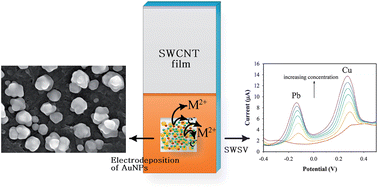Simultaneous detection of ultratrace lead and copper with gold nanoparticles patterned on carbon nanotube thin film†
Abstract
Highly sensitive detection of a Pb2+–Cu2+ mixture using

* Corresponding authors
a
Department of Bionano Engineering, Hanyang University, Ansan 426-791, South Korea
E-mail:
ghseong@hanyang.ac.kr
Fax: +82-31-436-8148
Tel: +82-31-400-5202
Highly sensitive detection of a Pb2+–Cu2+ mixture using

 Please wait while we load your content...
Something went wrong. Try again?
Please wait while we load your content...
Something went wrong. Try again?
M. Ngoc Bui, C. A. Li, K. N. Han, X. Pham and G. H. Seong, Analyst, 2012, 137, 1888 DOI: 10.1039/C2AN16020J
To request permission to reproduce material from this article, please go to the Copyright Clearance Center request page.
If you are an author contributing to an RSC publication, you do not need to request permission provided correct acknowledgement is given.
If you are the author of this article, you do not need to request permission to reproduce figures and diagrams provided correct acknowledgement is given. If you want to reproduce the whole article in a third-party publication (excluding your thesis/dissertation for which permission is not required) please go to the Copyright Clearance Center request page.
Read more about how to correctly acknowledge RSC content.
 Fetching data from CrossRef.
Fetching data from CrossRef.
This may take some time to load.
Loading related content
